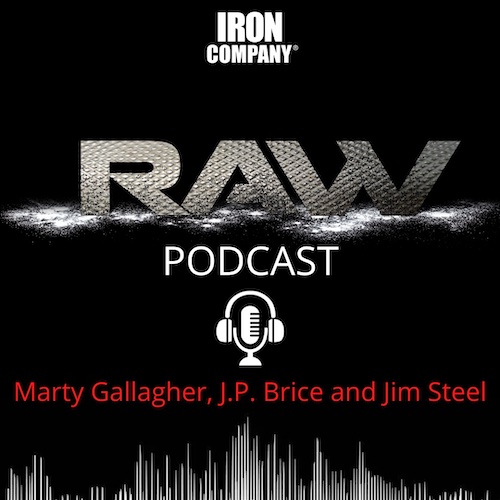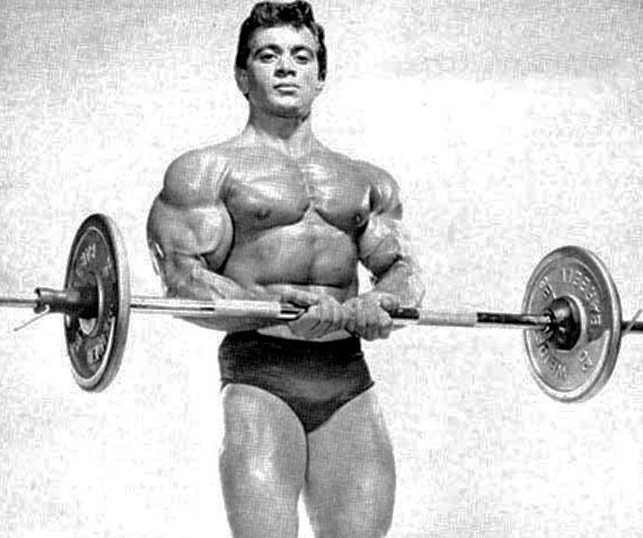
Don’t forget to train ARMS
Not too much, not too little, just right….
Arm Idol Freddy Ortiz circa 1965: 15-year-old Marty saw this photo and immediately began doing narrow-grip barbell curls. The 5’5” Ortiz boasted honest 19-inch arms. He worked them thrice weekly using a massive amount of volume. He worked them hard, heavy, and often. Note “revolving sleeve” barbell set like I had.
Arm training. Why is it that boys and men become fixated on big arms? Big arms have always been a masculine hallmark. And equally important – small arms lower a man’s status in the wolfpack. Big arms have a magical attraction for alpha boys. It did for me. When I was a kid, big arms were a big deal. Why is it that big arms are so important for alpha males? I think it is instinctive, intuitive, and somehow encoded in our primordial DNA.
As a preteen and teen, I bought muscle mags and would gaze in wide wonder at the massive arms of Larry Scott, Reg Park, Marvin Eder, Leroy Colbert, Bill Pearl, Harold Poole, and Sergio Oliva. Freddy Ortiz had the best biceps of that first wave of “modern” (1960s forward) bodybuilders. Freddy’s peaked biceps prefigured Arnold’s arms, the most famous of all time. While biceps were great, I was a triceps fanboy.
I knew triceps made up the bulk of the arm and were critical in bench pressing, incline pressing, and overhead pressing. I lost my 15-year-old mind over the relaxed arm photos of Bill Pearl. While most to the bodybuilders of the era were graceful gazelles, Pearl (and Reg Park) was a rhino. I wanted to look like a rhino, not a gazelle.
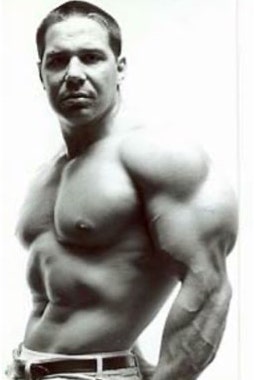
Bill Pearl’s “cold” left tricep.
As a teenage Olympic weightlifter and powerlifter, I worked the hell out of my triceps. I did an insane amount of overhead pressing. We did flat bench pressing and lots of weighted dips. Whole body routines were done three times a week. I ate food like every meal was my last one prior to being sent to the electric chair.
Locally, my arm mentor was a good one: Iron Man triple-threat Mickey Collins. Mickey was a DC legend and for good reason: as an Olympic weightlifter he trained with national champion and Olympic silver medalist, Jim Bradford, the 3rd man in history to crash the 400-pound overhead press barrier. Under Bradford’s supervision, Mickey won the junior nationals as an Olympic weightlifter in the 181-pound class: press 275, snatch 265 and clean and jerk 355.
Over the next five years, he added 20-pounds of muscle and won Mr. DC, this on the same day he had raw squatted 600, raw bench pressed 425, and deadlifted 645 to win the DCAAU powerlifting title. Weighing 205, Mickey had 19-inch arms.
Good looking, he had a terrific job with the federal government. He was a snazzy dresser, had a great bachelor pad, and lots of good-looking girlfriends. He spent time with me and gave me training advice when we trained Saturdays at Gonzaga high school, right by Union Station in downtown DC. He was a flesh-and-blood man mentor and arm mentor.
One thing Mickey set me straight on was that, for arms (and every muscle group and body part) there is a “hierarchy” amongst progressive resistance exercises. “Son,” Mikey intoned in his lilting, honied way of speaking “…not all exercises are created equal.” Properly done dips are a better triceps exercise than a properly done triceps kickbacks; barbell cheat curls are superior to anemic machine curls. Here is our exercise hierarchy for triceps and biceps…
Top five tricep exercises (in order)
- Weighted dips: John McCallum called dips “squats, for the upper body.” Master no weight dips, when you are capable of 3 sets of 10 reps, start strapping on poundage. Only dip to parallel; too deep dilutes results.
- Narrow-grip bench press: 18-inches or less. Touch-and-go style, you can handle the most poundage. Exaggerate the lockout; all the triceps results occur at the top of the rep – no “soft lockouts”
- Nose-breakers: instead of bench pressing the barbell or EZ-curl bar, break at the elbows and lower the bar towards the face. The elbows and upper arm are stabilized. Again, emphasize the lockout.
- Single dumbbell overhead tricep press: this classic movement uses a single dumbbell grasped with two hands and lowered down behind the head. Get a terrific stretch at the bottom of rep; use a full ROM.
- Cable pushdowns with various handles: differing cable attachment handles create differing effects. Cables make for great triceps “finishing” exercise. Do not make cable pushdowns your lead-off triceps exercise.
Top five bicep exercises
- Cheat curls: done right these are the premier bicep exercise for constructing size. Factually, these should be called “barely” cheat curls. Ideally the curler uses a slight layback, barely enough to finish each curl.
- Seated and incline dumbbell curls: dumbbell curls force each bicep to do its fair share of the work. Sit bolt upright, or curl on an incline. Various degrees of incline produce differing bicep effects.
- Braced curls: Any type of curl done while immobilizing the upper arm; stabilize the triceps and isolate the biceps with preacher curls, spider curls, bench curls, etc.,
- Cable curls: cables curls using a straight bar or individual handles, require the user cut a unique pathway through time and space on every rep. Cable curls are done standing, seated, braced, from all angles.
- Machine curls: lowest on the curl totem pole are machine curls. A machine eliminates the 3rd dimension of tension, the need to control side-to-side sway, ergo, muscle stabilizers fail at fire.
Frequency, sets, and reps, tend to fall into one of two distinct approaches: high frequency/high volume/moderate intensity - or - low frequency/low volume/high intensity. Two men, both from the same era, each representational of one extreme of the arm training, i.e., “volume versus intensity” pendulum. These exact training routines were excerpted from Ric Wayne’s 1978 bodybuilding classic training bible, 3 More Reps…
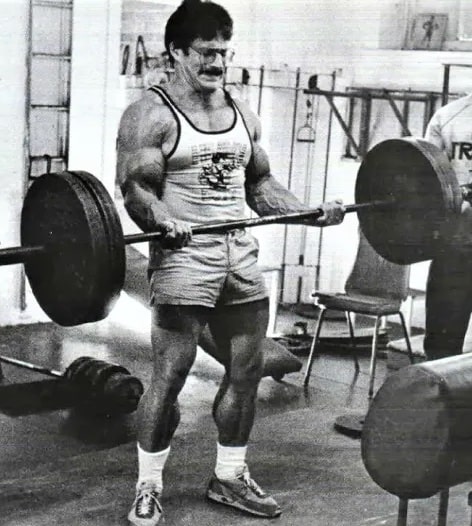
Monday & Thursday Triceps (three super-sets)
Nautilus triceps extension to failure
Weighted dips to failure
The triceps extensions pre-fatigue the triceps. The dips, utilizing front delts, and pecs, allow the triceps to be taken past failure, thereby ensuring hypertrophy.
Tuesday & Friday (three tri-sets)
Forced rep barbell curls to failure
Concentration curl w/dumbbell to failure
Preacher curl to failure
Cheat curls are followed by concentration curls followed immediately by a set of preacher curls, 1-2-3 with NO rest. Repeat twice with zero rest between any exercise: nine sets of biceps in a row. Done twice a week.
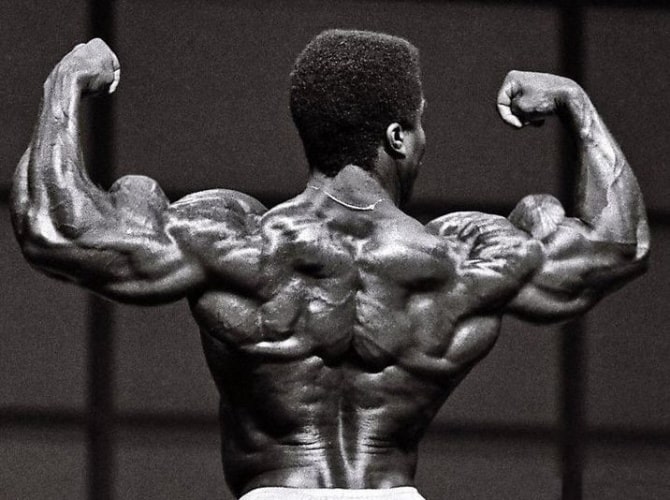
Tuesday, Thursday, Saturday
Cheat curls, barbell 8 sets 6-8 reps
Seated incline curls 6 sets 8 reps
Concentration curls 6 sets 10 reps
Close grip BB curls 6 sets 12 reps
One arm tricep stretch 6 sets 10 reps
Nose-breakers 6 sets 8 reps
Tricep pushdowns 6 sets 8-10 reps
Dips 6 sets 10-12 reps
Pack a lunch: 50 sets of arms done thrice weekly – 150 sets a week for arms alone.
In an interesting side-by-side comparison, Mentzer does 18 sets a week for biceps and triceps while Robbie does 150 sets per week for biceps and triceps. The other famous minimalist trainer, Dorian Yates, trained even less than Mentzer: five sets of biceps and six sets of triceps, done once a week. At the other extreme, the godfather of biceps, the owner of the most famous arms in the world, Arnold Schwarzenegger, did 162 sets a weeks for biceps, triceps, and forearms.
Conclusions? Work your arms. How often? Yates works his arms once weekly, Mentzer worked his twice weekly, Robbie, Arnold, Franco worked their arms three times a week. There is an inverse relationship between intensity and volume: low volume only works when amplified by maximum intensity; conversely, the longer you train, the more the intensity must be reduced. To make it through a 50-set arm workout, you must curtail the intensity. You cannot sprint a marathon and you cannot lollygag a sprint. Sets and reps? 5-12 rep sets seem to be the lower and outer limits. There is no (intentional) single, double or triple-rep sets in arm training. There is a hierarchy of arm exercises: pay attention and pay heed. Also: arms are always trained last in a workout. Any time I see a man walk into a weight room and start a training session with curls, I know I am looking at an egotistical fool. Arms are most often done after chest-bench training. Don’t overemphasize, don’t neglect.
About the Author - Marty Gallagher
As an athlete Marty Gallagher is a national and world champion in Olympic lifting and powerlifting. He was a world champion team coach in 1991 and coached Black's Gym to five national team titles. He's also coached some of the strongest men on the planet including Kirk Karwoski when he completed his world record 1,003 lb. squat. Today he teaches the US Secret Service and Tier 1 Spec Ops on how to maximize their strength in minimal time. As a writer since 1978 he’s written for Powerlifting USA, Milo, Flex Magazine, Muscle & Fitness, Prime Fitness, Washington Post, Dragon Door and now IRON COMPANY. He’s also the author of multiple books including Purposeful Primitive, Strong Medicine, Ed Coan’s book “Coan, The Man, the Myth, the Method" and numerous others. Read the Marty Gallagher Biography for a more in depth look at his credentials as an athlete, coach and writer.


